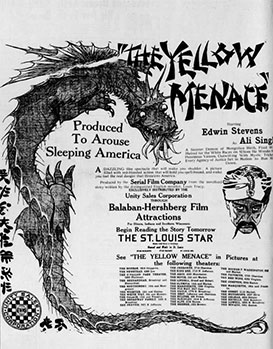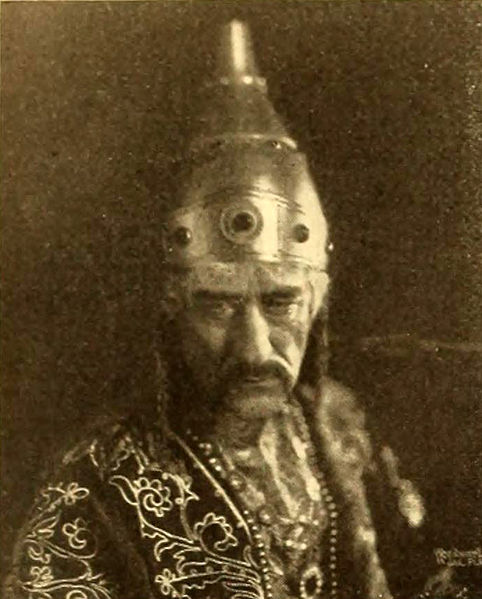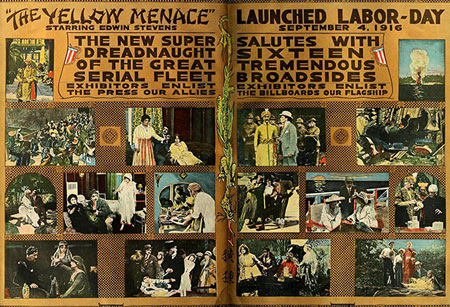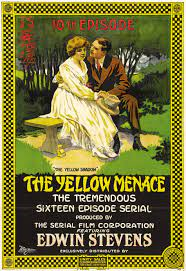Y …is for
The Yellow Menace
Among the greatest of those threats, many believed, was the “Yellow Peril” or “Yellow Terror”—that is, the “sinister Oriental,” an evil mastermind who was determined to destroy the West and who had at his disposal “limitless hordes” ready to overrun America and other “white” countries.
The Yellow Menace was hardly the first picture to demonize Asians or depict them as threats to American sovereignty and the American way of life. Many other films of that period had emphasized the fear of Asians and minorities in order to stoke hatred. Serials such as the Whartons’ The Exploits of Elaine and Beatrice Fairfax (produced with financial support from Hearst), for example, had featured sinister Asian characters desperate to expose American secrets and undermine national interests. Other serials released in the same year as The Yellow Menace had a similar theme. For example, in The Secret of the Submarine, a fifteen-episode thriller released by Mutual, Cleo Burke, together with Lt. Jarvis Hope, foils the efforts by agents of the Japanese and Russian governments to steal plans for a new submarine that can remain underwater indefinitely by means of an apparatus that operates like the gills of a fish and thereby establish military superiority.
Today, apart from its overt racism, the serial is most remembered as the chapter-play debut of Frank Lackteen, a Lebanese-born actor who would go on to portray villainous ethnics, from “Orientals” and Arabs to Native Americans and “half-breeds” in hundreds of serial episodes and action melodramas until his retirement in 1965.
Survival Status: Presumed lost.
Director: Aubrey M. Kennedy (according to Progressive Silent Movie List)—although Lahue, in Continued New Week, lists William Steiner as director.
Release Date: September 4, 1916
Release Company: Serial Film Company, Inc., likely distributed, on a State Right basis, by Unity Sales Corporation
Cast: Edwin Stevens (Ali Singh), Florence Malone (Princess Nadice), Marguerite Gale (Margaret Brown), Armand Cortes (“Hong Kong” Harry), David Wall (J.D. Bronson), Tina Marshall (Mary Manning), Eric Mayne (Errol Manning), J. Albert Hall (Captain Kent), William McKey (Porcupine Patterson), Roy Gahris (Foo Jong), Mary T. Rose (Miss Mirell), Frank Lackteen (Chinese Heavy), Marie Treador, Emile La Croix, Gerald Griffin.
Episodes: (two reels each) 1. Hidden Power. 2. The Mutilated Hand. 3. The Poisonous Tarantula. 4. Plot of a Demon. 5. The Haunted House. 6. The Torture Chamber. 7. Drops of Blood. 8. The Time-Clock Bomb. 9. The Crystal Globe. 10. A Message from the Sky. 11. The Half-Breed’s Hatred. 12. Aeroplane Accident. 13. The Spy and the Submarine. 14. Interrupted Nuptials. 15. The Pay of Death. 16. The Final Strand.




